#nuclear accidents
Photo
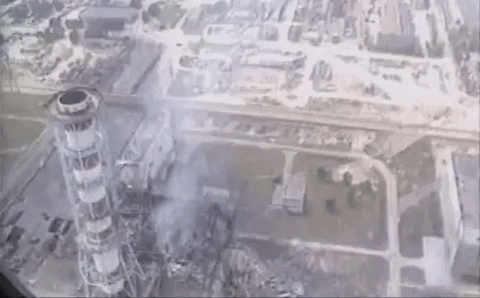



#Chernobyl#Helicopter crashes#crash#helicopter#acidente#nuclear power plant#Prypyat#Pryp’yat#nuclear accidents#radiative#liquidator#my gifs#my gif#gif#my edit
223 notes
·
View notes
Text
The Most Dangerous Film in the World
Three days after the explosion and meltdown of Chernobyl’s Nuclear Reactor Unit 4 on April 26, 1986, Soviet filmmaker Vladimir Shevchenko was granted permission to fly over the 30-square-kilometer site known as the Exclusion Zone. His assignment was to document the cleanup operations being carried out by Ukrainian workers and volunteers, most of whom would eventually succumb to the extraordinarily high levels of radiation they were exposed to while trying to contain the disaster.

When Shevchenko’s 35mm footage was later developed, he noticed that a portion of the film was heavily pockmarked and carried extraneous static interference and noise. Thinking initially that the film stock used had been defective, Shevchenko eventually realized that what he had captured on film was the image and sound of radioactivity itself.

This article is adapted from Susan Schuppli’s book “Material Witness: Media, Forensics, Evidence.” Buy the book: Amazon, Bookshop, more options
Upon projection, small flares of light momentarily ignite the surface of the film. Sparking and crackling, they conjure a pyrotechnics of ghostly defects that are the consequence of decaying radioactive particles moving through the exterior casing of Shevchenko’s 35mm Konvas camera to activate the emulsive properties of the film. What we are witness to, in this fleeting energetic event, is the radiological conversion of a somewhat pedestrian account of the disaster into the most dangerous film in the world.
“Radiation is a fatal invisible foe. One that even penetrates steel plating. It has no odor, nor color. But it has a voice. Here it is. We thought this film was defective. But we were mistaken. This is how radiation looks,” Shevchenko narrates over the film. “This shot was taken when we were allowed a 30-second glimpse from the armored troop-carrier. On that April night the first men passed here — without protection or stop-watches, aware of the danger, as soldiers performing a great feat. Our camera was loaded with black-and-white film. This is why the events of the first weeks will be black and white, the colors of disaster.”
Shevchenko’s film, “Chernobyl: Chronicle of Difficult Weeks,” provides us with an intimate view into the space of disaster. And while its pictorial mediation allows us to remain at a safe and objective distance from the hazard, the sudden distortion of the documentary’s sound and images, and the Geiger-like interference of radiation, inaugurates a sense of dread that what we are witnessing on film is in fact the unholy representation of the real: an amorphous and evil contagion that continues to release its lethal discharges into the present and future yet to come.
The contaminated film footage thus complicates the conventional partitioning of time by hurling us unwittingly back into the contact zone of the event — not merely as viewers but also as witnesses to an event whose time has not yet passed. Even when I am watching a safe VHS copy of this film, I am reminded of the transgressive agency of the nuclear to contravene the material borders that traditionally maintain the integrity between human and nonhuman entities, between bodies and images, between past and present.
Given what we know about the radical chemistry and anarchic temporality of nuclear materials, it is impossible to fully distance ourselves from this fallout on film, regardless of how far removed we believe ourselves to be from the event in both space and time.
The detonation of the first nuclear weapon in 1945 altered the planet’s baseline levels of ionizing radiation irrevocably as newly created isotopes such as caesium-134 and 137 began to supplement naturally occurring cosmic and terrestrial radiation. Although caesium-137 first appeared in the early solar system through processes of natural nuclear fission, more than 1.7 billion years would pass before it reappeared on Earth in any detectable amount — on December 2, 1942, as a result of a nuclear chain reaction produced by the first-ever human-made nuclear reactor, the Chicago Pile-1, built under the supervision of physicist Enrico Fermi.
In the decades that immediately followed Fermi’s experiment, “humanity began to significantly change the global radiation environment by testing nuclear weapons in the atmosphere,” as a sobering article charting the fallout from nuclear weapons tests explains. “By the early 1960s, there was no place on Earth where the signature of atmospheric nuclear testing could not be found in soil, water and even polar ice.”
By extension, Shevchenko’s contaminated film, whether the original 35mm print or its VHS copy, signals an intensification of an already increasingly “unnatural” radiological world where anthropogenic contamination would become omnipresent. The interference that we observe within the image field of “Chronicle of Difficult Weeks” is a tacit reminder that the nuclear always operates in excess of containment and is thus ontologically predisposed to breaching imposed limits, whether they are film frames, reactor units, or remote test sites.
Although radiation is effectively everywhere, events around Chernobyl unfolded in such a way as to negate the scale and extent of the accident, and even initially to deny that it ever happened. As one Polish protestor would scrawl months later on his placard, in an antinuclear demonstration held after the USSR reluctantly admitted that an incident had occurred in the Ukraine: “Chernobyl is everywhere — except in the East.”
The irradiated image matter of Shevchenko’s documentary offers a paradigmatic account of a material witness in which trace evidence of an external event — the nuclear accident at Chernobyl — is registered directly by changes in the material composition of the artifact, producing information that opens up the artifact to further analysis and critical reflection.
In the case of Shevchenko’s defective film stock, there can be no dispute that the radioactive isotopes released into the atmosphere by the reactor meltdown — at a magnitude 400 times greater than that of the atomic bomb over Hiroshima — were the source of the film’s contamination, and thus offered compelling evidence as to the scale and migrating nature of the disaster. Indeed, subsequent radiation readings also confirmed that all of his film equipment, including his Konvas and cherished Arriflex cameras, had been severely exposed, thus requiring their immediate decommissioning and disposal. Shevchenko himself died less than a year later, in March 1987.
The public contexts in which Chernobyl’s contaminants would come to feature as evidence that a major nuclear accident had occurred largely took place outside of the Soviet Union. Only when Sweden — after picking up unusually high levels of radiation — threatened to file an official alert with the International Atomic Energy Agency did the Soviet Union admit privately that there had been some sort of incident at Chernobyl. In the political aftermath of the tragedy at Chernobyl, the failure to inform its citizens served to expose the hubris of the Soviet State, which hid the disaster from the public, acted far too slowly in disclosing and managing the risk, covered up negligence in the reactor’s operational procedures, and ultimately exposed millions to unnecessary poisoning, especially as the contaminating winds blew northwest across the Ukrainian border into Belarus, and onward into Poland and Sweden.
Activities were underway for May Day celebrations throughout the USSR; Soviet officials felt that it would dampen festive spirits if news of the nuclear meltdown and potential health hazards were publicized during this period. As a result, atmospheric molecules carrying ionizing radiation entered into the respiratory systems of thousands of unsuspecting hosts. Children, it turned out, were the most susceptible to this migrating airborne malevolence. Radiation affects cells in the thyroid gland above all, which in young people are in an active state of duplication or growth. Consequently, irradiated cells were turned out at unprecedented metabolic rates, spawning, in turn, statistically abnormal increases in the incidents of thyroid tumors among children.
Today, an estimated 3.5 million Ukrainians are still plagued with maladies linked to Chernobyl; many of them have received little or no compensation for their suffering. The situation in Belarus, recipient of 70 percent of Chernobyl’s airborne contaminants, is even grimmer.

Cover of Pravda newspaper, April 26, 1986, day of the Chernobyl nuclear accident; and cover of Pravda newspaper, May 15, 1986. Nineteen days after the accident at Chernobyl, President
Mikhail Gorbachev made a television address to the Soviet people.
A subsequent legal trial was organized entirely around procedural failings rather than the admission of any evidential artifacts of a material nature. In this regard, State silence around the various material expressions of nuclear contamination could more aptly be described as disclosing the management of the disaster as a “nonevent.” If the material witness’s dual obligation is to act as a registration system that archives trace evidence of events as well as accounting for the appearance of such evidence within the contested spaces of public discourse, then the willful lack of public acknowledgment for 19 harrowing days — the length of time before Soviet newspapers registered publicly that a major nuclear accident had taken place — could be said to constitute an event in and of itself. Silence, secrecy, and the withdrawal of the conventions of public speech should be understood as modes of evidence-making in their own right.
Within this context of denial, Shevchenko’s film is a material witness, and a hostile one at that, in both the literal and legal sense of the term. As a materially compromised artifact the film inadvertently offered up damaging testimony that was willfully antagonistic to the narratives of nuclear containment and crisis management that were being advanced by the State via their commissioning of the documentary, with its focus on cleanup operations.
As the airborne malevolence of Chernobyl moved beyond the borders of the Ukraine in the days immediately following the accident, the failure of the State to discharge its civil obligations was an act of malfeasance; one in which political silence was eventually reconfigured as evidence of gross negligence, and rematerialized in the form of public protest and anger. Today Chernobyl is regarded as the political catalyst that led to the collapse of the Soviet Union on December 26, 1991.
#The Most Dangerous Film in the World#radiation#radio active film#chernobyl#radiation accidents#nuclear accidents#4/26/86#Soviet filmmaker Vladimir Shevchenko
13 notes
·
View notes
Text
I've been watching a lot of videos about nuclear disasters lately, and it's unsettling how many of them can be explained with the following memes:
The Management:
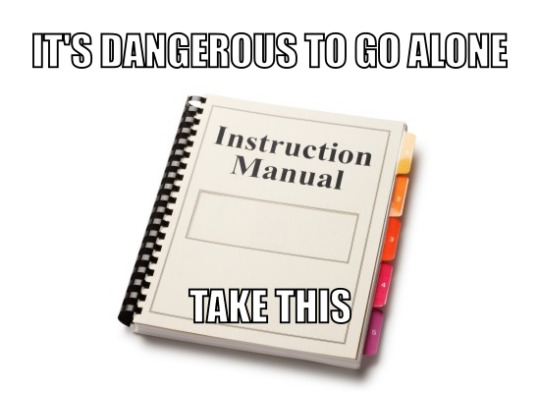
The Staff:

The Nuclear Material:

The Staff:

4 notes
·
View notes
Video
youtube
America’s worst nuclear accident: Three Mile Island
“In retrospect, it’s not surprising that the memory of Three Mile Island is so negative, and so inaccurate.”
#videos#nuclear power#nuclear accident#nuclear accidents#nuclear disaster#nuclear disasters#misinformation#nuclear meltdown#nuclear meltdowns#pennsylvania#three mile island#capitalism#transparency#government transparency
5 notes
·
View notes
Text
*goes on a rampage about the therac-25 and how fucked it was that no one was paying attention to that shit*
#therac-25#nuclear accidents#holy fucking shit#why are we like this#what the fuck is wrong with healthcare specialists
1 note
·
View note
Text
How “Dumb Money” Nuke Power Plants Boil & Bankrupt The Earth
How “Dumb Money” Nukes Boil & Bankrupt The Earth
View On WordPress
0 notes
Text
Nuclear accidents can happen in Europe too: Former Russian President: Report 14Aug 2022
Nuclear accidents can happen in Europe too: Former Russian President: Report 14Aug 2022
Nuclear accidents can happen in Europe too: Former Russian President
Former Russian President Dmitry Medvedev has issued a veiled threat to Ukraine’s Western allies, who have accused Russia of risking nuclear catastrophe by deploying forces around Ukraine’s Zaporizhzhya nuclear plant.
Ukraine has accused Russia of firing on Ukrainian cities on the knowledge that the Ukrainian military could not…

View On WordPress
#dks express#nuclear accident ukraine#nuclear accidents#nuclear accidents and holocaust#nuclear accidents can happen in europe too#ukraine russia latest news#ukraine russia news
1 note
·
View note
Text
Stained glass windows in the administrative building of the Chernobyl nuclear power plant.







The Chernobyl Nuclear Power Plant was one of the largest in the Soviet Union and the poster child of the Soviet nuclear power industry. As such, little expense was spared on details like these windows.
The Soviet Union often used motifs in abstract art to promote Communism and laude their successes.
For more info, check out my reblog of this post.
#chernobyl#socialist realism#soviet union#ussr aesthetic#soviet art#ussr (former soviet union)#nuclear power#radiation#accidents and disasters#1k#2k#history#reactor#disaster#stained glass#nuclear#propaganda#soviet propaganda#autism#ussr art#chernobyl hbo#chnpp
4K notes
·
View notes
Text

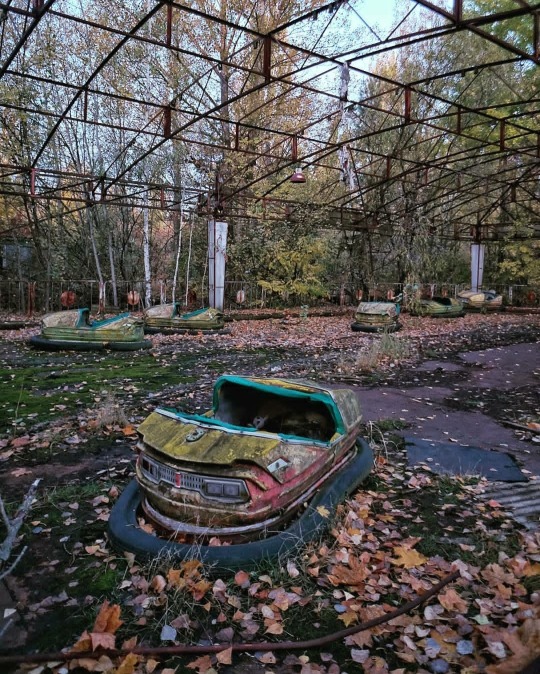
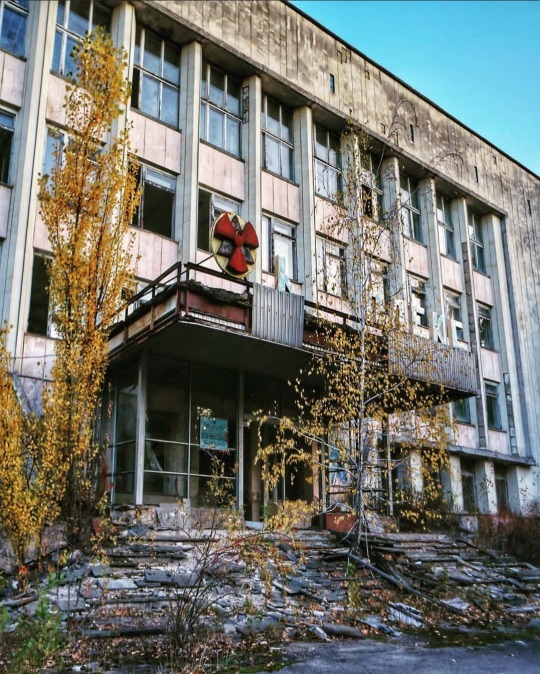




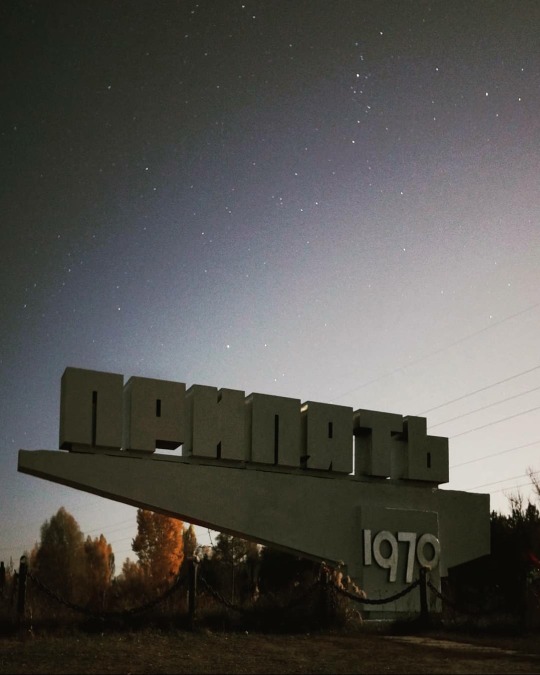
ℭ𝔥𝔢𝔯𝔫𝔬𝔟𝔶𝔩 𝔈𝔵𝔠𝔩𝔲𝔰𝔦𝔬𝔫 ℨ𝔬𝔫𝔢
📷 𝔩𝔞𝔫𝔞𝔰𝔞𝔱𝔬𝔯
#Chernobyl#prypiat#chernobyl exclusion zone#radiation#accident#ukraine#pripyat#nuclear#nuclear power plant#ferris wheel#park#abandoned#ghost town
288 notes
·
View notes
Text
sorry it's still so funny that crypto and nfts like exploded and died after all that nonsense pyramid scheme scam shit and superbowl ads and bitcoin mining rigs ruining everything including the environment and it was all for nothing, it didn't change the world it didn't revolutionize anything it was all a complete scam and what remains of it still is. like blockchain tech isn't going anywhere it's probably going to exist in some capacity for the foreseeable future and crypto in general still exists (and existed before it became mainstream popular) but the vast majority of nfts, cryptocurrencies, etc are completely and utterly worthless now, shut down services, crashed markets and exchanges, etc. the only sad things are the people left holding the bag whose lives were ruined bc they got sucked into the scam and there's no justice or recompense + the sheer amt of environmental damage caused by this whole thing
#i find everything abt crypto fascinating in the same way some people are obsessed w nuclear accidents#thinking abt all of this within its material context is so interesting. the horrifying garbage economics of the whole thing#the whole thing was & still is essentially a decentralized mlm scheme . casino gambling type shit. just wild#the fucking ape nfts... how was that even real#theres no way to describe any of this w/o sounding like a jackass. bc the whole thing is fundamentally jackassery
121 notes
·
View notes
Photo

Palomares, Spain. In 1966 two American military airplanes collided in flight and 4 thermonuclear bombs fell to the ground. Two of them released 20kg Plutonium. Today, 57 years later, the US government has promised to remove the contaminated soil and carry it to America.
161 notes
·
View notes
Text

(sorry for leaving y’all in suspense I was grocery shopping) Surprise!! I accidentally got into Len’en like two weeks ago. Whoops! I got ideas for cool drawings to do with each of the BPoHC shrine team members (and you-know-who, ofc, but that one might be… weird lol), but Tsubakura gets to go first cause theirs is the simplest; just greyscale + red color scheme with a split background and the pose is mostly random (maybe they’re squishing Tsurubami’s little eye thing? Idk). Very pleased with how everything worked out; the line for the eye is exactly where the dividing line for the background was and the way I managed to make the vest corseted while not changing the ribbon placement is just perfect. Although I did make their hat smaller out of the aforementioned cowardice also that thing is hard to draw
#art#digital#len’en#tsubakura enraku#for those not in the know: Len’en is a game series inspired by Touhou but there’s a number of things different about it and it is rapidly#spiraling off into a very complicated story and also other game genres; also every character’s gender is officially ‘whatever’#This character (Tsubakura) plays like Marisa but is also a shrine maiden (priest) along with the Reimu type character#Nonbinary (to me) mad scientist.#Replaces soy sauce with calligraphy ink in every culinary application.#Made a nuclear bomb once supposedly on accident.#Locked in a blood feud with their 3(ish) absurdly powerful ex-girlfriends and this has led to at least one actual war. so far#(hello high brightness users! :D)#Apparently mastered genetic engineering and mostly uses it for stuff like making it so they can put ink in their coffee and not die from it#what’s not to love#oh ya I doubt anyone cares much since this was in the tags but I got some stuff wrong due to misunderstanding & exaggeration for comedy sryy#nuclear bomb was definitely an accident cause they got really sad about it after which is soooooo funny#they do eat ink and also soap but it’s not really explained why it doesn’t kill them of why they like it#also they made an artificial human (+ several androids) who’s supposed to be an assassin and used to be an even more blatant mega reference#hasn’t actually killed anyone yet cause their first target is Tsubakura lol#and I’m barely exaggerating abt the ex girlfriend thing; they haven’t been confirmed to have dated in canon but they were quote#‘close enough to want to murder each other’#and one of them is very homoerotic about it all the time so like rlly not that out of pocket#admittedly the one I’m drawing somewhat homoerotic art of with Tsubakura atm is probably one of the other two but whateverrrr#it still fits Arde well enough#*mgs reference
36 notes
·
View notes
Text
I know it is in part me not being the target audience but it is so funny to me when you see those "are your parents divorced" polls on tumblr that have zero options for "my parents aren't married"
you are functionally indistinguishable from small children who think marriage is where babies come from
#average tumblr user cannot fathom a family dynamic outside of the nuclear family everyone point and laugh#accident baby sweeeeeep
36 notes
·
View notes
Text
Hello!
Apologies for my sudden disappearance again 😭 I hope everyone is doing okay!
I've got news! First of all, happy new year 2014 ,,☺️
Second of all, I am rebranding my MSM AU, Loodvigg's Day at Disneyland. I lost motivation to write it, but l've somehow grown deeply attached to it. So I turned AU Loodvigg into an OC... erm hi Viggy sorry you're a furry now

They're going to be an important character in an OC story I'm planning to develop! I'm basically gonna implant the story I had for LDaD into this character and his own backstory. And I've got a lot planned for this fella... By the way, their name is Guillaz!
Ok so that's it that's the announcement. Uh. I won't go more into detail for now but yeah! I might post the art concepts I had for LDaD in an art dump at some point.
Okay back to my hibernation... Zzz
#SORRY IT’S VERY SUDDEN I’ve got this idea for a while actually#Loodvigg’s Day at Disneyland#LDaD AU#Basically the whole plot for LDaD: Loodvigg messes up#Then they get exiled to the human world by Galvana and somehow end up to Disneyland#(the human world with no humans nor living beings since they all died in a nuclear accident)#Being alone makes Loodvigg realize their pasts mistakes so they end up feeling terrible#They become insane and they die.#The end#Okay no it was actually way cooler in my head. BUT yeah that’s more or less the entire plot ☺️☺️☺️😊🙏#My Singing Monsters
37 notes
·
View notes
Text
most irritating part of recovery so far is that i keep having existential panic attacks about death + the future every couple days. it's pretty clearly because i am not currently ready to be done here & it freaks me the Fuck Out that last year i could feel the end coming to the point of making total peace with it & i am terrified that the 50-odd years i've wrested back could be torn away from me at any moment. which is like, yeah, this is a completely reasonable post-traumatic response. could you cut it out tho.
usually telling myself "i'll be ready for this when it happens" comforts me. but occasionally i'll just lay here staring at the ceiling like. I Could Get Shot Tomorrow,
#i live in the US i can die SO EASILY of COVID or getting shot or car accidents even if climate catastrophe + nuclear war doesnt manifest#like the chances are Slim. BUT I'D LIKE THEM TO BE ZERO. I'M NOT DONE HERE YET#cant stop thinking about my damn antibodies being off the charts last year.#the difference between 'i feel like i'm gonna die' and 'i am going to die' is so vast. and difficult to explain 2 ppl who havent been there#autoimmune tag#negative#i suppose. just a vent post
30 notes
·
View notes